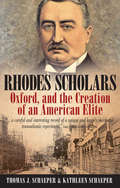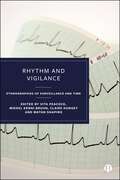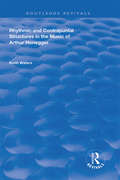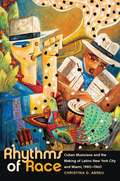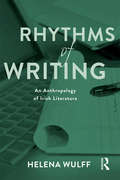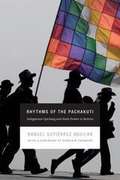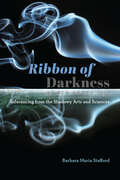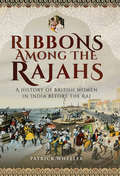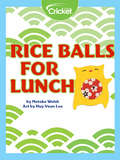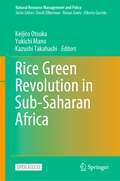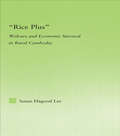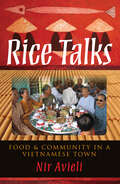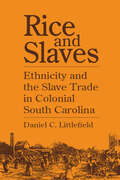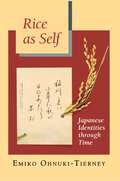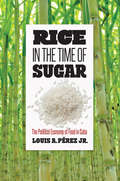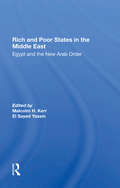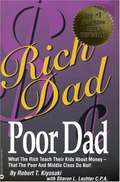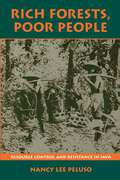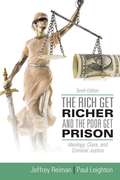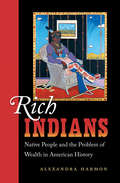- Table View
- List View
Rhodes Scholars, Oxford, And The Creation Of An American Elite
by Thomas J. Schaeper Kathleen SchaeperEach year thirty-two seniors at American universities are awarded Rhodes Scholarships, which entitle them to spend two or three years studying at the University of Oxford. The program, founded by the British colonialist and entrepreneur Cecil Rhodes and established in 1903, has become the world's most famous academic scholarship and has brought thousands of young Americans to study in England. Many of these later became national leaders in government, law, education, literature, and other fields. Among them were the politicians J. William Fulbright, Bill Bradley, and Bill Clinton; the public policy analysts Robert Reich and George Stephanopoulos; the writer Robert Penn Warren; the entertainer Kris Kristofferson; and the Supreme Court Justices Byron White and David Souter. Based on extensive research in published and unpublished documents and on hundreds of interviews, this book traces the history of the program and the stories of many individuals. In addition it addresses a host of questions such as: how important was the Oxford experience for the individual scholars? To what extent has the program created an old-boy (-girl since 1976) network that propels its members to success? How many Rhodes Scholars have cracked under the strain and failed to live up to expectations? How have the Americans coped with life in Oxford and what have they thought of Britain in general? Beyond the history of the program and the individuals involved, this book also offers a valuable examination of the American-British cultural encounter.
Rhythm Science (Mediaworks Pamphlets)
by Paul D. MillerThe art of the mix creates a new language of creativity."Once you get into the flow of things, you're always haunted by the way that things could have turned out. This outcome, that conclusion. You get my drift. The uncertainty is what holds the story together, and that's what I'm going to talk about."—Rhythm ScienceThe conceptual artist Paul Miller, also known as Dj Spooky that Subliminal Kid, delivers a manifesto for rhythm science—the creation of art from the flow of patterns in sound and culture, "the changing same." Taking the Dj's mix as template, he describes how the artist, navigating the innumerable ways to arrange the mix of cultural ideas and objects that bombard us, uses technology and art to create something new and expressive and endlessly variable. Technology provides the method and model; information on the web, like the elements of a mix, doesn't stay in one place. And technology is the medium, bridging the artist's consciousness and the outside world.Miller constructed his Dj Spooky persona ("spooky" from the eerie sounds of hip-hop, techno, ambient, and the other music that he plays) as a conceptual art project, but then came to see it as the opportunity for "coding a generative syntax for new languages of creativity." For example: "Start with the inspiration of George Herriman's Krazy Kat comic strip. Make a track invoking his absurd landscapes...What do tons and tons of air pressure moving in the atmosphere sound like? Make music that acts a metaphor for that kind of immersion or density." Or, for an online "remix" of two works by Marcel Duchamp: "I took a lot of his material written on music and flipped it into a DJ mix of his visual material—with him rhyming!" Tracing the genealogy of rhythm science, Miller cites sources and influences as varied as Ralph Waldo Emerson ("all minds quote"), Grandmaster Flash, W. E. B Dubois, James Joyce, and Eminem. "The story unfolds while the fragments coalesce," he writes. Miller's textual provocations are designed for maximum visual and tactile seduction by the international studio COMA (Cornelia Blatter and Marcel Hermans). They sustain the book's motifs of recontextualizing and relayering, texts and images bleed through from page to page, creating what amount to 2.5 dimensional vectors. From its remarkable velvet flesh cover, to the die cut hole through the center of the book, which reveals the colored nub holding in place the included audio CD, Rhythm Science: Excerpts and Allegories from the Sub Rosa Archives, this pamphlet truly lives up to Editorial Director Peter Lunenfeld's claim that the Mediawork Pamphlets are "theoretical fetish objects...'zines for grown-ups."
Rhythm and Vigilance: Ethnographies of Surveillance and Time
by Vita Peacock, Mikkel Kenni Bruun, Claire Elisabeth Dungey, and Matan ShapiroAvailable open access digitally under CC-BY-NC-ND licence. Studies of surveillance have emphasised how technology is used to control space. This innovative collection examines how new monitoring technologies are also affecting the experience of time. Drawing on Henri Lefebvre’s concept of rhythm, the book brings together ethnographic research from Europe, China and the US, to show how digital monitoring is transforming spatio-temporal relations across the Global North. As digital technologies continue to reshape the rhythms of life, this book makes a valuable contribution to both anthropology and surveillance studies.
Rhythmic and Contrapuntal Structures in the Music of Arthur Honegger
by Keith WatersThis title was first published in 2002. Through analyses of a number of Honegger's compositions, including extended analyses of two of Honegger's orchestral works, "Mouvement symphonique No. 2 (Rugby)" and "Symphonie pour cordes", Keith Waters examines the principles of musical organization in Honegger's music and shows how these principles are based on systematic rhythmic and contrapuntal strategies. Musical form in Honegger's work, the book argues, is articulated by contrapuntal and rhythmic structures rather than by tonal structure, and it is this that provides the source of compositional unity in Honegger's music.
Rhythms of Labour: Music at Work in Britain
by Emma Robertson Marek Korczynski Michael PickeringWhether for weavers at the handloom, labourers at the plough, or factory workers on the assembly line, music has often been a key texture in people's working lives. This book is the first to explore the rich history of music at work in Britain and charts the journey from the singing cultures of pre-industrial occupations, to the impact and uses of the factory radio, via the silencing effect of industrialisation. The first part of the book discusses how widespread cultures of singing at work were in pre-industrial manual occupations. The second and third parts of the book show how musical silence reigned with industrialisation, until the carefully controlled introduction of Music While You Work in the 1940s. Continuing the analysis to the present day, Rhythms of Labour explains how workers have clung to and reclaimed popular music on the radio in desperate and creative ways.
Rhythms of Race
by Christina D. AbreuAmong the nearly 90,000 Cubans who settled in New York City and Miami in the 1940s and 1950s were numerous musicians and entertainers, black and white, who did more than fill dance halls with the rhythms of the rumba, mambo, and cha cha cha. In her history of music and race in midcentury America, Christina D. Abreu argues that these musicians, through their work in music festivals, nightclubs, social clubs, and television and film productions, played central roles in the development of Cuban, Afro-Cuban, Latino, and Afro-Latino identities and communities. Abreu draws from previously untapped oral histories, cultural materials, and Spanish-language media to uncover the lives and broader social and cultural significance of these vibrant performers.Keeping in view the wider context of the domestic and international entertainment industries, Abreu underscores how the racially diverse musicians in her study were also migrants and laborers. Her focus on the Cuban presence in New York City and Miami before the Cuban Revolution of 1959 offers a much needed critique of the post-1959 bias in Cuban American studies as well as insights into important connections between Cuban migration and other twentieth-century Latino migrations.
Rhythms of Writing: An Anthropology of Irish Literature
by Helena WulffThis is the first anthropological study of writers, writing and contemporary literary culture. Drawing on the flourishing literary scene in Ireland as the basis for her research, Helena Wulff explores the social world of contemporary Irish writers, examining fiction, novels, short stories as well as journalism. Discussing writers such as John Banville, Roddy Doyle, Colm Tóibín, Frank McCourt, Anne Enright, Deirdre Madden, Éilís Ní Dhuibhne, Colum McCann, David Park, and Joseph O´Connor, Wulff reveals how the making of a writer’s career is built on the ‘rhythms of writing’: long hours of writing in solitude alternate with public events such as book readings and media appearances. Destined to launch a new field of enquiry, Rhythms of Writing is essential reading for students and scholars in anthropology, literary studies, creative writing, cultural studies, and Irish studies.
Rhythms of the Pachakuti: Indigenous Uprising and State Power in Bolivia
by Stacey Alba Skar Raquel Gutiérrez AguilarIn the indigenous Andean language of Aymara, pachakuti refers to the subversion and transformation of social relations. Between 2000 and 2005, Bolivia was radically transformed by a series of popular indigenous uprisings against the country's neoliberal and antidemocratic policies. In Rhythms of the Pachakuti, Raquel Gutiérrez Aguilar documents these mass collective actions, tracing the internal dynamics of such disruptions to consider how motivation and execution incite political change."In Rhythms of the Pachakuti we can sense the reverberations of an extraordinary historical process that took place in Bolivia at the start of the twenty-first century. The book is the product of Raquel Gutiérrez Aguilar's political engagement in that historical process. . . . Though of Mexican nationality, [she] was intimately involved in Bolivian politics for many years and acquired a quasi-legendary status there as an intense, brilliant activist and radical intellectual. . . . [Her account is] . . . itself a revolutionary document. . . . Rhythms of the Pachakuti deserves to stand as a key text in the international literature of radicalism and emancipatory politics in the new century."--Sinclair Thomson, from the foreword
Ribbon of Darkness: Inferencing from the Shadowy Arts and Sciences
by Barbara Maria StaffordOver the course of her career, Barbara Stafford has established herself the preeminent scholar of the intersections of the arts and sciences, articulating new theories and methods for understanding the sublime, the mysterious, the inscrutable. Omnivorous in her research, she has published work that embraces neuroscience and philosophy, biology and culture, pinpointing connections among each discipline’s parallel concerns. Ribbon of Darkness is a monument to the scope of her work and the range of her intellect. At times associative, but always incisive, the essays in this new volume take on a distinctly contemporary purpose: to uncover the ethical force and moral aspects of overlapping scientific and creative inquiries. This shared territory, Stafford argues, offers important insights into—and clarifications of—current dilemmas about personhood, the supposedly menial nature of manual skill, the questionable borderlands of gene editing, the potentially refining value of dualism, and the limits of a materialist worldview. Stafford organizes these essays around three concepts that structure the book: inscrutability, ineffability, and intuitability. All three, she explains, allow us to examine how both the arts and the sciences imaginatively infer meaning from the “veiled behavior of matter,” bringing these historically divided subjects into a shared intellectual inquiry and imbuing them with an ethical urgency. A vanguard work at the intersection of the arts and sciences, this book will be sure to guide readers from either realm into unfamiliar yet undeniably fertile territory.
Ribbons Among the Rajahs: A History of British Women in India Before the Raj
by Patrick WheelerFrom the mid-eighteenth century onwards, British women started traveling in any numbers to the East Indies, mostly to accompany husbands, brothers or fathers. Very little about them is recorded from the earlier years, about the remarkable journeys that they made and what drove them to travel those huge distances. Some kept journals, others wrote letters, and for the first time Patrick Wheeler tells their story in this fascinating and colorful history, exploring the little-known lives of these women and their experiences of life in India before the Raj.With a perceptive approach, Ribbons Among the Rajahs considers all aspects of women's lives in India, from the original discomfort of traversing the globe and the complexities of arrival through to creating a home in a tight-knight settlement community. It considers, too, the effects of the subservience of women to the needs of men and argues for the greater fusion of European cultures that existed prior to imperial times.
Ricanness: Enduring Time in Anticolonial Performance
by Sandra RuizHonorable Mention, 2020 Barnard Hewitt Award for Outstanding Research in Theatre History, given by the American Society for Theatre ResearchArgues that Ricanness operates as a continual performance of bodily endurance against US colonialismIn 1954, Dolores “Lolita” Lebrón and other members of the Puerto Rican Nationalist Party led a revolutionary action on the chambers of Congress, firing several shots at the ceiling and calling for the independence of the island. Ricanness: Enduring Time in Anticolonial Performance begins with Lebrón’s vanguard act, distilling the relationship between Puerto Rican subjectivity, gender, sexuality, and revolutionary performance under colonial time.Ruiz argues that Ricanness—a continual performance of bodily endurance against US colonialism through different measures of time—uncovers what’s at stake politically for the often unwanted, anticolonial, racialized and sexualized enduring body. Moving among theatre, experimental video, revolutionary protest, photography, poetry, and durational performance art, Ricanness stages scenes in which the philosophical, social, and psychic come together at the site of aesthetics, against the colonization of time. Analyzing the work of artists and revolutionaries like ADÁL, Lebrón, Papo Colo, Pedro Pietri, and Ryan Rivera, Ricanness imagines a Rican future through the time travel extended in their aesthetic interventions, illustrating how they have reformulated time itself through nonlinear aesthetic practices.
Rice Balls for Lunch
by Motoko WelshRice balls have been enjoyed in Japan for hundreds of years. You can learn to make some too!
Rice Green Revolution in Sub-Saharan Africa (Natural Resource Management and Policy #56)
by Keijiro Otsuka Yukichi Mano Kazushi TakahashiThis open access book seeks effective strategy to realize a rice Green Revolution in sub-Saharan Africa based on more than ten years of research team’s inquiries into determinants and consequences of new technology adoption in rice farming in seven countries in this region. Rigorous statistical analyses are carried out by using valuable household data of rice farmers. The book is actually sequel to the two earlier books on the same subject published by Springer and edited by K. Otsuka and D.F. Larson, An African Green Revolution published in 2013 and In Pursuit of an African Green Revolution in 2016. The main message of the first book was that rice is the most promising cereal crop in SSA because of the high transferability of Asian rice technology, whereas that of the second book was that rice cultivation training programs are effective in significantly increasing rice yield in SSA. This third book has wider coverage in terms of topics, study periods, and study sites. It continues to show the significant impacts of rice cultivation training on productivity and newly demonstrates the high sustainability of the productivity impact of the training and the existence of spillover effects from trainees to other farmers by using panel data. We newly assess the important role of mechanization in intensification of rice farming, high returns to large-scale irrigation schemes, and the critical role of rice millers in improving the quality of milled rice. Based on these studies, this book provides clear pathways toward full-fledged Green Revolution in rice farming in sub-Saharan Africa.
Rice Plus: Widows and Economic Survival in Rural Cambodia (New Approaches in Sociology)
by Susan H. LeeThis book explores the economic coping practices of rural widows in the aftermath of the Cambodian civil war. War produces a preponderance of widows, often young widows with small children in their care. Rural widows must feed their families and educate their children despite rural poverty and the lack of opportunities for women. The economics of widowhood is therefore a significant social problem in less developed countries. The widows' predominant economic plan was to combine rice cultivation with an assortment of microenterprises, a "rice plus" strategy. Many widows were unable to grow enough rice on their land to feed their families. They filled the hunger gap by raising cash through microenterprises to purchase additional rice. Gender work roles were both permeable and persistent, allowing a flexible sexual division of labor in the short run but maintaining traditional roles in the long run. Most widows called on relatives or exchanged transplanting labor for male plowing services, although a few women took up the plow themselves. The study also explores widows' access to key economic resources such as land, credit, and education. War decimated widows' family support networks, including the loss of children, their social security. The study concludes that Cambodia's gender arrangement offered many economic options to widows but also devalued their labor in a cultural structure of inequality. Gender, poverty, and war interacted to reduce widows' financial resources, accounting for their economic vulnerability.
Rice Talks: Food & Community in a Vietnamese Town
by Nir AvieliAn anthropological study of the culture surrounding food in a thriving Vietnamese town.Rice Talks explores the importance of cooking and eating in the everyday social life of Hoi An, a prosperous market town in central Vietnam known for its exceptionally elaborate and sophisticated local cuisine. In a vivid and highly personal account, Nir Avieli takes the reader from the private setting of the extended family meal into the public realm of the festive, extraordinary, and unique. He shows how foodways relate to class relations, gender roles, religious practices, cosmology, ethnicity, and even local and national politics. This evocative study departs from conventional anthropological research on food by stressing the rich meanings, generative capacities, and potential subversion embedded in foodways and eating.“In this very engaging narrative Avieli captures the flavor and richness of everyday lowland Vietnamese life, as well as the trials and tribulations of attempting to eke out a livelihood, fit within family hierarchical structures, and correctly pay homage to the necessary deities and ancestors.” —Sarah Turner, McGill University“Readers with an interest in Vietnamese, Southeast Asian, and Asian cuisines and/or the influences of colonialism on local foodways will find the work useful. . . . Filled with descriptions of meals and dishes likely to get the culinarily-minded reader drooling. And almost any non-academic writer planning to do food-related research anywhere in the world could take something away from the final chapter, which discusses the practicalities of this type of research.” —Robyn Eckhardt, author of EatingAsia
Rice and Slaves: Ethnicity and the Slave Trade in Colonial South Carolina (Blacks in the New World)
by Daniel C. LittlefieldDaniel Littlefield's investigation of colonial South Carolinianss preference for some African ethnic groups over others as slaves reveals how the Africans' diversity and capabilities inhibited the development of racial stereotypes and influenced their masters' perceptions of slaves. It also highlights how South Carolina, perhaps more than anywhere else in North America, exemplifies the common effort of Africans and Europeans in molding American civilization.
Rice as Self: Japanese Identities through Time
by Emiko Ohnuki-TierneyAre we what we eat? What does food reveal about how we live and how we think of ourselves in relation to others? Why do people have a strong attachment to their own cuisine and an aversion to the foodways of others? In this engaging account of the crucial significance rice has for the Japanese, Rice as Self examines how people use the metaphor of a principal food in conceptualizing themselves in relation to other peoples. Emiko Ohnuki-Tierney traces the changing contours that the Japanese notion of the self has taken as different historical Others--whether Chinese or Westerner--have emerged, and shows how rice and rice paddies have served as the vehicle for this deliberation. Using Japan as an example, she proposes a new cross-cultural model for the interpretation of the self and other.
Rice in the Time of Sugar: The Political Economy of Food in Cuba
by Louis A. PérezHow did Cuba's long-established sugar trade result in the development of an agriculture that benefited consumers abroad at the dire expense of Cubans at home? In this history of Cuba, Louis A. Perez proposes a new Cuban counterpoint: rice, a staple central to the island's cuisine, and sugar, which dominated an export economy 150 years in the making. In the dynamic between the two, dependency on food imports—a signal feature of the Cuban economy—was set in place.Cuban efforts to diversify the economy through expanded rice production were met with keen resistance by U.S. rice producers, who were as reliant on the Cuban market as sugar growers were on the U.S. market. U.S. growers prepared to retaliate by cutting the sugar quota in a struggle to control Cuban rice markets. Perez's chronicle culminates in the 1950s, a period of deepening revolutionary tensions on the island, as U.S. rice producers and their allies in Congress clashed with Cuban producers supported by the government of Fulgencio Batista. U.S. interests prevailed—a success, Perez argues, that contributed to undermining Batista's capacity to govern. Cuba's inability to develop self-sufficiency in rice production persists long after the triumph of the Cuban revolution. Cuba continues to import rice, but, in the face of the U.S. embargo, mainly from Asia. U.S. rice growers wait impatiently to recover the Cuban market.
Rice, Agriculture, and the Food Supply in Premodern Japan: The Place Of Rice (Needham Research Institute Series)
by Charlotte von Verschuer Wendy CobcroftThe majority of studies on the agricultural history of Japan have focused on the public administration of land and production, and rice, the principal source of revenue, has received the most attention. However, while this cereal has clearly played a decisive role in the public economy of the Japanese State, it has not had a predominant place in agricultural production. Far from confining its scope to a study of rice growing for tax purposes, this volume looks at the subsistence economy in the plant kingdom as a whole. This book examines the history of agriculture in premodern Japan from the 8th to the 17th century, dealing with the history of agricultural techniques and food supply of rice, wheat, millet and other grains. Drawing extensively on material from history, literature, archaeology, ethnography and botany, it analyses each of the farming operations from sowing to harvesting, and the customs pertaining to consumption. It also challenges the widespread theory that rice cultivation has been the basis of "Japaneseness" for two millennia and the foundation of Japanese civilization by focusing on the biodiversity and polycultural traditions of Japan. Further, it will play a role in the current dialogue on the future of sustainable agricultural production from the viewpoints of ecology, biodiversity, dietary culture and food security throughout the world as traditional techniques such as crop rotation are explored in connection with the safeguarding of the minerals in the soil. Surveying agricultural techniques across the centuries and highlighting the dietary diversity of Japan, this book will appeal to students and scholars of Japanese history, the history of science and technology, medieval history, cultural anthropology and agriculture.
Rice, Rupees, and Ritual: Economy and Society Among the Samosir Batak of Sumatra
by D. ShermanIn this ethnographic study of the small mountain village of Huta Ginjang in the Samosir area of northern Sumatra, the author pursues three main themes: the role of rice in the Batak economy of feasting, and the cultural ecology of dry- and flooded-field rice-growing. Two important questions emerge: How did the social and economic changes resulting from Dutch colonization - particularly the adoption of money as a medium of exchange - affect Samosir Batak culture/ Have the values that largely shape the local economy been fundamentally altered by the effects of colonization and subsequent Japanese and Indonesian administrations? After introductory chapters present the environmental and historical background of the Samosir region, the author describes the socio-cultural base on which its agricultural economy rests: indigenous political and religious institutions, concepts of patrilineal descent and marriage alliance, and, most importantly, the ideology of the feasting system. He then examines in detail and in comparative perspective the agricultural practices of Huta Ginjang, and also deals more generally with the economic relations and institutions of the villagers, notably marketing, credit, and cooperative endeavours. Since the key production units are nuclear families, the author analyzes the development of households and the organization of labor in cultivating crops. He then turns to the distribution of livestock and land by both ritual and nonritual means. The book is illustrated with photographs, line drawings, and maps.
Rich And Poor States In The Middle East: Egypt And The New Arab Order
by Malcolm H. Kerr El Sayed Yassin Jeswald Salacuse Ismail SerageldinWhile oil wealth has enriched some Middle East Arab nations, others that lack oil resources have remained poor and are looking now to their oil-rich neighbors for development assistance. This collection of studies on the economic, social, and political relationships between the haves and the have-nots in the Middle East focuses on Egypt-the largest state in the region-and on its prospects for change based on financial assistance from other Arab countries.The authors have many disagreements about the future of both rich and poor nations in the Middle East and considerable skepticism about the possibility of transforming Egypt, but they do agree that the future must be projected in the framework of a new regional order in which oil wealth, labor migration, and liberalized national economies are fundamental realities.
Rich Dad, Poor Dad: What the Rich Teach Their Kids About Money - That the Poor and Middle Class Do Not!
by Robert T. Kiyosaki Sharon L. LechterThe main reason people struggle financially is because they have spent years in school but learned nothing about money. The result is that people learn to work for money, but never learn to have money work for them.
Rich Forests, Poor People: Resource Control and Resistance in Java
by Nancy Lee PelusoMillions of Javanese peasants live alongside state-controlled forest lands in one of the world's most densely populated agricultural regions. Because their legal access and customary rights to the forest have been severely limited, these peasants have been pushed toward illegal use of forest resources. Rich Forests, Poor People untangles the complex of peasant and state politics that has developed in Java over three centuries.Drawing on historical materials and intensive field research, including two contemporary case studies, Peluso presents the story of the forest and its people. Without major changes in forest policy, Peluso contends, the situation is portentous. Economic, social, and political costs to the government will increase. Development efforts will by stymied and forest destruction will continue. Mindful that a dramatic shift is unlikely, Peluso suggests how tension between foresters and villagers can be alleviated while giving peasants a greater stake in local forest management.
Rich Get Richer and the Poor Get Prison, The (Subscription): Ideology, Class, and Criminal Justice
by Jeffrey Reiman Paul LeightonIllustrates the issue of economic inequality within the American justice system. The best-selling text, The Rich Get Richer and the Poor Get Prison contends that the criminal justice system is biased against the poor from start to finish. The authors argue that even before the process of arrest, trial, and sentencing, the system is biased against the poor in what it chooses to treat as crime. The authors show that numerous acts of the well-off--such as their refusal to make workplaces safe, refusal to curtail deadly pollution, promotion of unnecessary surgery, and prescriptions for unnecessary drugs--cause as much harm as the acts of the poor that are treated as crimes. However, the dangerous acts of the well-off are almost never treated as crimes, and when they are, they are almost never treated as severely as the crimes of the poor. Not only does the criminal justice system fail to protect against the harmful acts of well-off people, it also fails to remedy the causes of crime, such as poverty. This results in a large population of poor criminals in our prisons and in our media. The authors contend that the idea of crime as a work of the poor serves the interests of the rich and powerful while conveying a misleading notion that the real threat to Americans comes from the bottom of society rather than the top. Learning Goals Upon completing this book, readers will be able to: Examine the criminal justice system through the lens of the poor. Understand that much of what goes on in the criminal justice system violates one's own sense of fairness. Morally evaluate the criminal justice system's failures. Identify the type of legislature that is biased against the poor.
Rich Indians Native People and the Problem of Wealth in American History
by Alexandra HarmonLong before lucrative tribal casinos sparked controversy, Native Americans amassed other wealth that provoked intense debate about the desirability, morality, and compatibility of Indian and non-Indian economic practices. Skillfully blending social, cultural, and economic history, Alexandra Harmon examines seven such instances of Indian affluence and the dilemmas they presented both for Native Americans and for Euro-Americans--dilemmas rooted in the colonial origins of the modern American economy. This wide-ranging book looks at controversies concerning Powhatan economic status and aims during the Virginia colony's first years, the ambitions of some bicultural eighteenth-century Creeks and Mohawks, prospering Indians of the Southeast in the early 1800s, inequality among removed tribes during the Gilded Age, the spending of oil-rich Osages in the Roaring Twenties, resurgent tribal communities from Alaska to Maine in the 1970s, and casinos that have drawn gamblers to Indian country across the United States since the 1990s. Harmon’s study not only compels us to look beyond stereotypes of greedy whites and impoverished Indians, but also convincingly demonstrates that Indians deserve a prominent place in American economic history and in the history of American ideas through the twentieth century. Long before lucrative tribal casinos sparked controversy, Native Americans amassed other wealth that provoked intense debate about the desirability, morality, and compatibility of Indian and non-Indian economic practices. Skillfully blending social, cultural, and economic history, Alexandra Harmon examines seven such instances of Indian affluence and the dilemmas they presented both for Native Americans and for Euro-Americans--dilemmas rooted in the colonial origins of the modern American economy. This wide-ranging book looks at controversies concerning Powhatan economic status and aims during the Virginia colony's first years, the ambitions of some bicultural eighteenth-century Creeks and Mohawks, prospering Indians of the Southeast in the early 1800s, inequality among removed tribes during the Gilded Age, the spending of oil-rich Osages in the Roaring Twenties, resurgent tribal communities from Alaska to Maine in the 1970s, and casinos that have drawn gamblers to Indian country across the United States since the 1990s. Harmon’s study not only compels us to look beyond stereotypes of greedy whites and impoverished Indians, but also convincingly demonstrates that Indians deserve a prominent place in American economic history and in the history of American ideas through the twentieth century.
